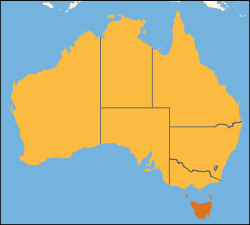A Fourteen Thousand Year Old Legend from Australia? March 20, 2014
Author: Beach Combing | in : Ancient, Prehistoric , trackbackThis morning ran across one of the most incredible examples of oral transmission or perhaps it would be better to say apparent oral transmission, I’ve ever stubbed my toe upon. First, some generally established facts depending, thank God, on geologists and geographers (not historians). Tasmania is today an island off the southern coast of Australia (dark orange on map) and as recently as 14,000 years ago Tasmania was connected to the Australian continental mass. Nothing strange there. Once upon a time America was connected to Asia and, for that matter, even longer ago everything was connected to everything. But consider now this early European report (1831) relating to the Tasmanian Aborigines (who were wiped out by nineteenth-century European colonization and whose fate we covered in a previous post):
The natives of the East Coast have a tradition that this Island was settled by migrants from a far country, that they came here on land, that the sea was subsequently formed.
The author here was George Augustus Robinson, a missionary who did his best for the Tasmanian Aborigines, the three hundred who had survived, but probably, in that fumbling, bumbling Victorian way, made matters even worse: Anglicans are not the best rescuers. GAR was, in any case, an intelligent chap and went on to wonder whether his Tasmanian informant had not actually been correct.
For aught we know [Van Diemen’s Land] might at an early period have been joined to [New Holland] in which case the tradition would be true.
And, of course, the tradition is true… but what is nice about this source is that GAR would hardly have made this up because he did not know that it was true!
Archaeologists have confirmed that it is possible perhaps even probable that Aborigines had inhabited Tasmania before it had separated from the mainland. But is it really conceivable that a memory could be passed over more than ten thousand years? drbeachcombing AT yahoo DOT com The answer must surely be no: oral historians get very anxious about traditions after three generations never mind several hundred. However, in the interests of an equitable debate it must be said that the legend is a strange one. The motif of an island separating from the mainland is not like a universal flood or lights in the sky (which crop up everywhere). WtH! Perhaps there are other examples, perhaps GAR misunderstood, perhaps this is all coincidence or a lucky guess?
20 March 2014: Southern Man writes ‘An obvious correction but the legend doesn’t say the land and Australia separated from each other. Perhaps this was a Tasmanian flood legend and the waters never receded?’ Thanks SM
21 March 2014: MACMAC with a fascinating parallel: In reference to your post on the separation of Tasmania from the mainland. Off the coast of South Australia is a reasonable sized island now called Kangaroo Island, separated by 14 kilometres from the mainland. In Pleistocene times it was connected to the mainland, and the passage has been under water for at least 10,000 years. Kangaroo Island was known as Naroongowie (also known as “the Sacred Island” or (cue music) “The isle of the dead” There is a local legend long considered to be a memory of the inundation: “Long ago, Ngurunderi’s two wives ran away from him, and he was forced to follow them. He pursued them and as he did so he crossed Lake Albert (the ocean exit of the Murray River across from Kangaroo Island) and went along the beach to Cape Jervis (the closest mainland point). When he arrived there he saw his wives wading half-way across the shallow channel which divided Naroongowie from the mainland. He was determined to punish his wives, and angrily ordered the water to rise up and drown them. With a terrific rush the waters roared and the women were carried back towards the mainland. Although they tried frantically to swim against the tidal wave they were powerless to do so and were drowned.” Local author M.H.Monroe reports: On the island there is plenty of evidence of occupation in prehistoric times. It is separated from South Australia by Backstairs Passage. This body of water would be very difficult to cross in canoes. It is subject to strong currents, heavy tidal swells and steep breaking seas. The first evidence of Aboriginal habitation on Kangaroo Island was the discovery of hammer stones at Hawk’s Nest near Murray’s Lagoon in 1903. In 1930 more stone tools were discovered and excavation was proposed. It was based on the finds at Kangaroo Island that the first suggestion was made that colonisation by Aborigines might date from the Pleistocene. The Aborigines on the nearby mainland had no water craft capable of making the dangerous crossing, having only rafts and bark canoes that were propelled with poles. The method of transport to the island used by the original occupants had been puzzled over, the conclusion being that they probably reached the island at a time of low sea level. The occupation was thought to have probably occurred a long time ago, as indicated by the archaic nature of the tools, no similar tools being found on the mainland from more recent times. Further support for this conclusion was the fact that the dingo never reached the island, as was the case with Tasmania. Also, no small tools have been found that were used at more recent times on the mainland. An indication of the length of time since the isolation of the island by rising sea levels is that many of the animals and plants of the island have evolved a subspecies related to those on the mainland.’ Thanks MACMAC!
31 Jan 2015: Mike Dash and Southern Man sent in this updated newstory Thanks!



